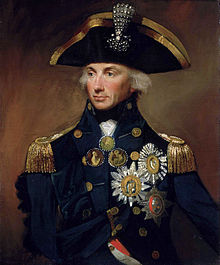Chelengk
| Chelengk of the Ottoman Empire | |
|---|---|
 Replica of Lord Nelson's diamond chelengk | |
| Type | Jewellery |
| Awarded for | Outstanding services to the state |
| Country | Ottoman Empire |
| Presented by | Ottoman Sultan |
| Eligibility | Civilians and military |
| Status | No longer awarded |
| Established | 1798 |
| Precedence | |
| Next (higher) | Order of Osmanieh |
| Next (lower) | Gallipoli Star |
A chelengk (Ottoman Turkish: چـلنك;[1] Turkish: çelenk, pronounced [tʃeˈlæɲc]) was a military decoration of the Ottoman Empire.
Turkish military award
[edit]Originally a çelenk was "a bird's feather which one attaches to the turban as a sign of bravery"[2] but by the end of the 18th century, the çelenk had become institutionalized in Ottoman military practice and continued to be awarded for military merit up to the 1820s.[3] It was a jewelled aigrette consisting of a central flower with leaves and buds, and upward-facing rays.
In modern Turkish, a çelenk is a wreath or garland, a circular decoration made from flowers and leaves, usually arranged as an ornament.
Gifts to non-Turkish naval heroes
[edit]
A specially-made chelengk was awarded to Horatio Nelson by Sultan Selim III in honour of the Battle of the Nile in 1798. This was the first time that a chelengk was conferred on a non-Ottoman.[3] The usual seven rays were augmented to thirteen, as described in a contemporary letter:
The Aigrette is a kind of feather; it represents a hand with thirteen fingers, which are of diamonds, and allusive to the thirteen ships taken and destroyed at Alexandria, the size that of a child's hand about six years old when opened; the center diamond and the four round it may be worth about £1000 each, and there are about 300 others well set.[4]
Nelson's chelengk was bought by the Society for Nautical Research in 1929 following a national appeal[5] and placed in the National Maritime Museum. It was stolen in 1951 by Taters Chatham and never recovered.[6]
Selim III also gave a chelengk to Russian Admiral Fyodor Ushakov after the capture of Corfu from the French in 1799.[citation needed]
See also
[edit]References
[edit]- ^ "Osmanlica Lûgât" [Ottoman Glossary] (in Turkish). Archived from the original on 5 September 2014. Retrieved 11 November 2012.
- ^ Abel Pavet de Courteille; Mahdī Khān Astarābādī & Muḥammed Khuweyyi (1870). Dictionnaire Turk-Oriental. Paris: Imprimerie impériale.
Plume d'oiseau qu'on attache sur le bonnet en signe de vaillance
- ^ a b "Ottoman Orders and Decorations as Forms of Honor". Ottoman Bank Archives and Research Centre. Archived from the original on 1 May 2012.
- ^ James Stanier Clarke; Stephen Jones; John Jones, eds. (1799). The Naval chronicle. Vol. 1. J. Gold. p. 340.
- ^ "The Chelengk of Nelson – Proposed Purchase for the Nation". The Times. London. 8 November 1929. p. 10 (with photograph).
- ^ "The Chelengk". The Art Fund. Archived from the original on 5 September 2014. Retrieved 11 November 2012.
Sources
[edit]- Roy Adkins & Lesley Adkins (2007). The War for All Oceans: From Nelson at the Nile to Napoleon at Waterloo. Abacus. p. 38. ISBN 978-0-349-11916-8.
- "Replica of Nelson's chelengk". National Maritime Museum.
